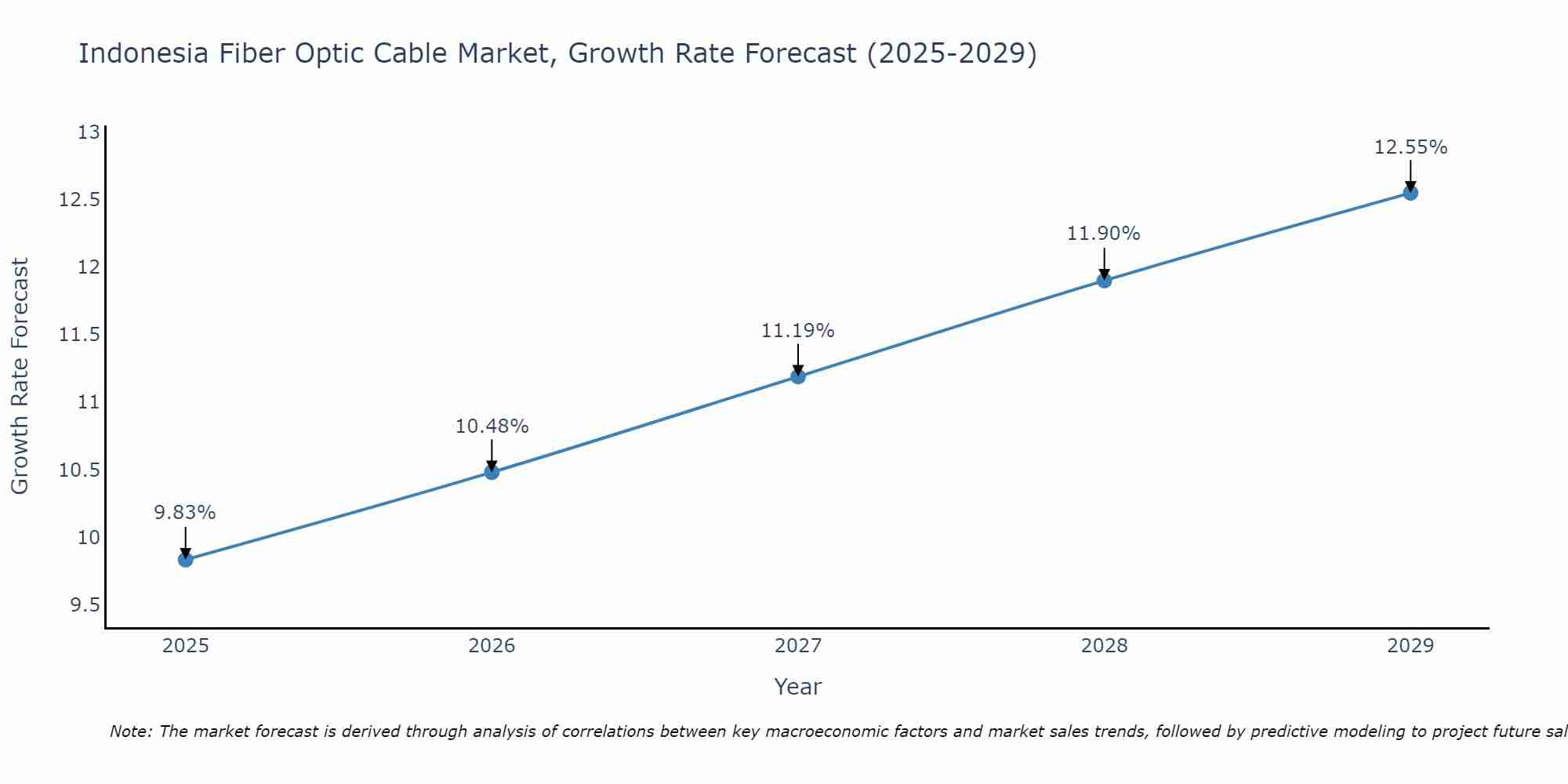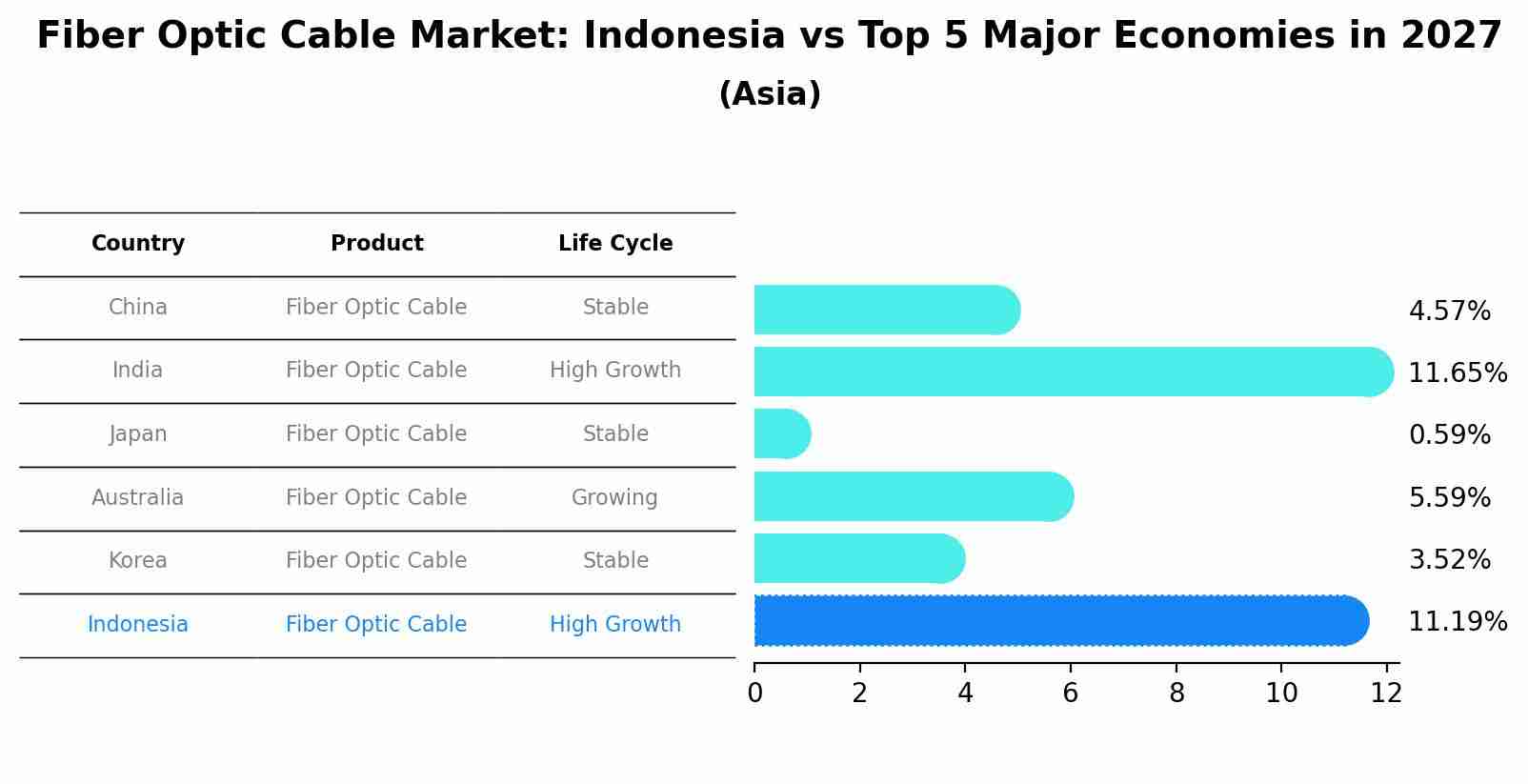Indonesia Fiber Optic Cable Market (2025-2031) Outlook | Analysis, Share, Trends, Growth, Industry, Forecast, Value, Size, Companies & Revenue
| Product Code: ETC363988 | Publication Date: Aug 2022 | Updated Date: Apr 2025 | Product Type: Market Research Report | |
| Publisher: 6Wresearch | Author: Ravi Bhandari | No. of Pages: 75 | No. of Figures: 35 | No. of Tables: 20 |
Indonesia Fiber Optic Cable Market Size Growth Rate
The Indonesia Fiber Optic Cable Market is poised for steady growth rate improvements from 2025 to 2029. Commencing at 9.83% in 2025, growth builds up to 12.55% by 2029.

Fiber Optic Cable Market: Indonesia vs Top 5 Major Economies in 2027 (Asia)
In the Asia region, the Fiber Optic Cable market in Indonesia is projected to expand at a high growth rate of 11.19% by 2027. The largest economy is China, followed by India, Japan, Australia and South Korea.

Indonesia Fiber Optic Cable Market Synopsis
The Indonesia Fiber Optic Cable market is witnessing rapid expansion as the country upgrades its telecommunications and internet infrastructure. Fiber optic cables provide high-speed and reliable internet connectivity, making them essential for telecommunications companies and internet service providers. The government`s efforts to improve digital connectivity and expand broadband access are driving the demand for fiber optic cables. As more businesses and households require faster internet services, the market for fiber optic cables is expected to grow significantly.
Drivers of the Market
The Indonesia Fiber Optic Cable market is experiencing strong growth driven by the country`s digital transformation initiatives and the expansion of telecommunications networks. Fiber optic cables are crucial for high-speed internet, data transmission, and improved connectivity. The government`s investments in broadband infrastructure and the increasing demand for high-definition streaming, cloud services, and 5G networks are key drivers. Moreover, the use of fiber optics in various industries, including healthcare and finance, further fuels the market as organizations seek faster and more reliable data transfer solutions.
Challenges of the Market
Fiber optic cable market challenges include the need for extensive infrastructure development. Expanding high-speed internet access and building a robust telecommunications network requires substantial investments and collaboration with local authorities. Additionally, competition from existing copper-based networks and the need for regular maintenance to prevent cable damage pose ongoing challenges.
COVID-19 Impact on the Market
The demand for fiber optic cables saw mixed impacts during the pandemic. While some sectors like telecommunications experienced increased demand for high-speed internet connectivity to support remote work and online activities, other sectors like construction and infrastructure faced delays, affecting the installation of fiber optic cables. Over time, the demand for reliable and fast internet connectivity drove growth in this market.
Key Players in the Market
The fiber optic cable market in Indonesia is experiencing robust growth, driven by the expansion of telecommunications networks and the increasing demand for high-speed internet connectivity. Key players in this market include international companies such as Huawei, Prysmian Group, and Corning Incorporated, as well as local manufacturers like PT Telekomunikasi Indonesia Tbk. These players supply a variety of fiber optic cables, solutions, and infrastructure to support Indonesia`s digital transformation and broadband expansion efforts. The market is highly competitive, with key players continually innovating to meet the evolving demands of the telecommunications sector.
Key Highlights of the Report:
- Indonesia Fiber Optic Cable Market Outlook
- Market Size of Indonesia Fiber Optic Cable Market, 2024
- Forecast of Indonesia Fiber Optic Cable Market, 2031
- Historical Data and Forecast of Indonesia Fiber Optic Cable Revenues & Volume for the Period 2021-2031
- Indonesia Fiber Optic Cable Market Trend Evolution
- Indonesia Fiber Optic Cable Market Drivers and Challenges
- Indonesia Fiber Optic Cable Price Trends
- Indonesia Fiber Optic Cable Porter's Five Forces
- Indonesia Fiber Optic Cable Industry Life Cycle
- Historical Data and Forecast of Indonesia Fiber Optic Cable Market Revenues & Volume By Cable Type for the Period 2021-2031
- Historical Data and Forecast of Indonesia Fiber Optic Cable Market Revenues & Volume By Single-Mode for the Period 2021-2031
- Historical Data and Forecast of Indonesia Fiber Optic Cable Market Revenues & Volume By Multi-Mode for the Period 2021-2031
- Historical Data and Forecast of Indonesia Fiber Optic Cable Market Revenues & Volume By Material for the Period 2021-2031
- Historical Data and Forecast of Indonesia Fiber Optic Cable Market Revenues & Volume By Glass for the Period 2021-2031
- Historical Data and Forecast of Indonesia Fiber Optic Cable Market Revenues & Volume By Plastic for the Period 2021-2031
- Historical Data and Forecast of Indonesia Fiber Optic Cable Market Revenues & Volume By Application for the Period 2021-2031
- Historical Data and Forecast of Indonesia Fiber Optic Cable Market Revenues & Volume By Communication for the Period 2021-2031
- Historical Data and Forecast of Indonesia Fiber Optic Cable Market Revenues & Volume By Power Transmission for the Period 2021-2031
- Historical Data and Forecast of Indonesia Fiber Optic Cable Market Revenues & Volume By Sensor for the Period 2021-2031
- Historical Data and Forecast of Indonesia Fiber Optic Cable Market Revenues & Volume By Others for the Period 2021-2031
- Indonesia Fiber Optic Cable Import Export Trade Statistics
- Market Opportunity Assessment By Cable Type
- Market Opportunity Assessment By Material
- Market Opportunity Assessment By Application
- Indonesia Fiber Optic Cable Top Companies Market Share
- Indonesia Fiber Optic Cable Competitive Benchmarking By Technical and Operational Parameters
- Indonesia Fiber Optic Cable Company Profiles
- Indonesia Fiber Optic Cable Key Strategic Recommendations
Frequently Asked Questions About the Market Study (FAQs):
- Single User License$ 1,995
- Department License$ 2,400
- Site License$ 3,120
- Global License$ 3,795
Search
Thought Leadership and Analyst Meet
Our Clients
Related Reports
- Afghanistan Apparel Market (2026-2032) | Growth, Outlook, Industry, Segmentation, Forecast, Size, Companies, Trends, Value, Share, Analysis & Revenue
- Canada Oil and Gas Market (2026-2032) | Share, Segmentation, Value, Industry, Trends, Forecast, Analysis, Size & Revenue, Growth, Competitive Landscape, Outlook, Companies
- Germany Breakfast Food Market (2026-2032) | Industry, Share, Growth, Size, Companies, Value, Analysis, Revenue, Trends, Forecast & Outlook
- Australia Briquette Market (2025-2031) | Growth, Size, Revenue, Forecast, Analysis, Trends, Value, Share, Industry & Companies
- Vietnam System Integrator Market (2025-2031) | Size, Companies, Analysis, Industry, Value, Forecast, Growth, Trends, Revenue & Share
- ASEAN and Thailand Brain Health Supplements Market (2025-2031) | Strategy, Consumer Insights, Analysis, Investment Trends, Opportunities, Growth, Size, Share, Industry, Revenue, Segments, Value, Segmentation, Supply, Forecast, Restraints, Outlook, Competition, Drivers, Trends, Demand, Pricing Analysis, Competitive, Strategic Insights, Companies, Challenges
- ASEAN Bearings Market (2025-2031) | Strategy, Consumer Insights, Analysis, Investment Trends, Opportunities, Growth, Size, Share, Industry, Revenue, Segments, Value, Segmentation, Supply, Forecast, Restraints, Outlook, Competition, Drivers, Trends, Demand, Pricing Analysis, Competitive, Strategic Insights, Companies, Challenges
- Europe Flooring Market (2025-2031) | Outlook, Share, Industry, Trends, Forecast, Companies, Revenue, Size, Analysis, Growth & Value
- Saudi Arabia Manlift Market (2025-2031) | Outlook, Size, Growth, Trends, Companies, Industry, Revenue, Value, Share, Forecast & Analysis
- Uganda Excavator, Crane, and Wheel Loaders Market (2025-2031) | Strategy, Consumer Insights, Analysis, Investment Trends, Opportunities, Growth, Size, Share, Industry, Revenue, Segments, Value, Segmentation, Supply, Forecast, Restraints, Outlook, Competition, Drivers, Trends, Demand, Pricing Analysis, Competitive, Strategic Insights, Companies, Challenges
Industry Events and Analyst Meet
Whitepaper
- Middle East & Africa Commercial Security Market Click here to view more.
- Middle East & Africa Fire Safety Systems & Equipment Market Click here to view more.
- GCC Drone Market Click here to view more.
- Middle East Lighting Fixture Market Click here to view more.
- GCC Physical & Perimeter Security Market Click here to view more.
6WResearch In News
- Doha a strategic location for EV manufacturing hub: IPA Qatar
- Demand for luxury TVs surging in the GCC, says Samsung
- Empowering Growth: The Thriving Journey of Bangladesh’s Cable Industry
- Demand for luxury TVs surging in the GCC, says Samsung
- Video call with a traditional healer? Once unthinkable, it’s now common in South Africa
- Intelligent Buildings To Smooth GCC’s Path To Net Zero


















